
Stanislavsky as an actor (top) and director (right).
Konstantin Stanislavsky
and The Method
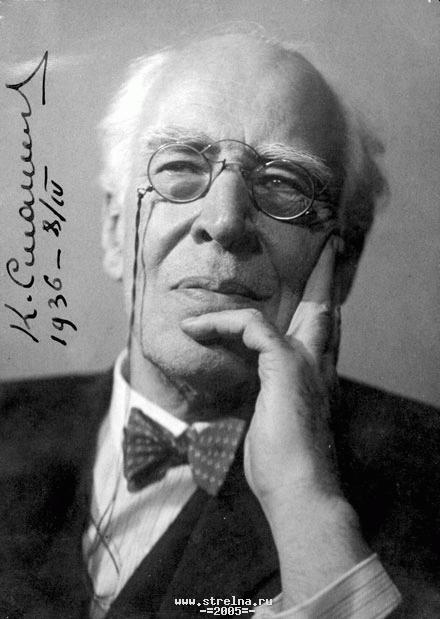
Konstantin Sergeyevich Stanislavsky was a Russian actor and theatre director. He was born on January 17, 1863. He had a more profound effect on the process of acting than anyone else in the twentieth century. At age 14, Stanislavsky joined a theatre group organized by his family, and soon became its central figure. Throughout the late 1800s he improved as an actor and began to produce and direct plays. At the age of 25, he established the Moscow Art Theatre which became famous for realistic performances of plays by a new generation of Russian playwrights like Anton Chekhov and Maxim Gorki.
Stanislavsky's thought that if the theater was going to be meaningful it needed to move beyond the external representation that it had primarily been. In 19th Century, Russia, as elsewhere, actors would strut on stage as they saw fit and deliver their lines downstage to the audience, without any regard to addressing fellow actors. The acting training that did exist counseled actors on how to "look" frightened or appear angry, but above all how to be heard and recognized. Actors didn't think of characters as "real" or of having an inner life, but as stock "types" that were always played in a certain way. In addition there was really no such thing as a true rehearsal process as we know it today.
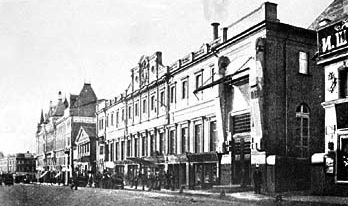
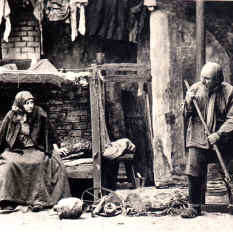
The Moscow Art Theatre in the 1900's A play employing Stanislavsky's new realism
The Method
Stanislavsky believed that being an actor was a serious artistic undertaking involving dedication and discipline. Over forty years he created an approach that emphasized the psychological and emotional aspects of acting. The Stanislavsky System, or the method, as it has become known, holds that an actor’s main responsibility is to be believed.
With the method, actors for the first time could not merely rely on stock characters and imitation, they had to draw on their own personal experience as well as their imagination in order to emotionally feel their characters. In so doing they would achieve "truth" or believability. Throughout his life Stanislavsky developed several concepts that are all aimed at this end.
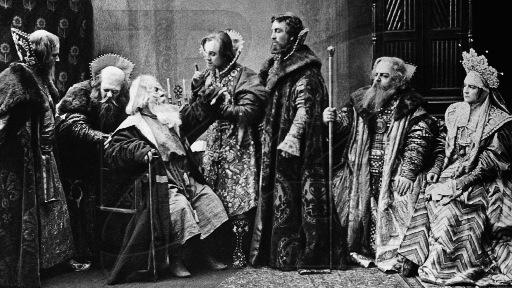
One of Stanislavsky's Productions at the Moscow Art Theatre
Emotion Memory
One of Stanislavsky's early concepts was emotion memory or affective memory. He believed that an actor should neither "force"or "fake" emotions on stage. Instead, with emotion memory, the actor remembers a situation when he/she felt the same, or similar, emotions as their character. Recalling the situation leads to true emotion. To prepare for a role that involves fear, for example, the actor must remember something frightening, and attempt to create their character in the "emotional space" of that fear they once felt. Stanislavsky found this process best suited to re-inventing emotions for performances night after night.
Sense Memory
Sense memory is similar to emotion memory. Stanislavsky's actors practiced using their senses to create a sense of reality on stage. For example, if their character just walked indoors and it was snowing outside, they may work on an exercise to remember what being outdoors in the snow feels like so they can have a strong sense of where they're coming from.
Physical Actions
Towards the end of his life, Stanislavsky placed emphasis on physical expression in training. He said that through the physical - the doing - an actor could give his role depth. He believed that actors must be in role all the time they are on stage, and most of the rehearsal time too, even if not required by the text to speak or carry out an action. This meant the actor should assume the role of their characters even during rehearsals. If the character had an injured leg then the actor should limp and alter his posture while rehearsing.
The "Magic If"
The 'magic if' is the basis of assuming the mentality of a character. An actor asks 'If I were there, what would I be thinking?' and then later 'If I were my character, what would I be thinking?' allowing realism to be naturally produced on stage. Stanislavsky did not require actors to be the part, as is a popular misconception, but he did demand that they lived the part with the magic if.
The Given Circumstance
This forms the context within which the actor asks the 'magic if', the basis for an actor and their role. The actor must believe in the given circumstances and appreciate them as truth. Given circumstances are: 1) the play's narrative; its facts, events, epoch, time and setting 2) the director's interpretation of the play; and, finally, 3) design elements - sets, costumes, lighting, sound, etc.
Imagination
A character often does not have a full biography. The actor must find details of a character's life from hints within the text or invent them. Stanislavsky demanded his actors to undergo a visual journey of motivation, including: who you are, where you came from, why, what you want, where you are going and what you will do when you get there. According to Stanislavsky, speaking lines without fully realizing the answer to these questions means not acting with your imagination.
Inner Monologue
Also referred to as subtext, these are the character's thoughts - what's going on inside the character during a scene regardless of whether or not the character is speaking. Stanislavsky believed that in order to make a character true, the character must be approached from the inside. Creating subtext is part of developing the inner life of the character.
Units and Objectives
The character's objective is what the character wants or is striving for. It is the actor's job to focus on the objective as their character would. Stanislavsky encouraged his actors to break each play down into units of action (which may or may not correspond to acts and scenes). In every unit, the character has an objective and faces a series of obstacles to overcome. There must not be too many units, but there should be enough to guide an actor towards realism. The super-objective of a play is the main thrust of the plot, an objective that runs throughout the entire text. It links to all the smaller objectives together. To gain understanding of a character, an actor must be aware of their character's relation to the super-objective.
Communion
Communion for Stanislavsky meant that an actor has to be able to trust that his fellow actors on stage are undergoing the same sort of transformation into character as he/she is. Everyone on stage is a community living within the given circumstances of the play, employing the 'magic if' themselves, and striving to achieve their own character's objectives. Before communicating the subtle nuances of the play with an audience an actor must get to know and trust the other actors he/she works with on stage as their characters and understand the character relationships between them.
Tempo and Rhythm
On stage, less experienced actors may fall victim to nerves and hurry
their lines and directions in order to get off as soon as possible. It
is an actor's responsibility to find the correct tempo rhythm of every
line and action performed. They should rehearse each line and action
until they find a suitable tempo rhythm.
Relaxation and Concentration
During his career as a young actor, Stanislavsky felt tense on stage. Later in life, he examined ways to help an actor relax and focus on stage. An actor could focus by concentrating on a small circle, himself and one other actor or prop. The actor, once focused on this small circle, extends his attention to a medium circle that includes more actors or larger props. After truly focusing on this, the actor can extend the focus of the large circle of attention to cover the entire stage. This idea is sometimes call "Circles of Attention." If an actor loses concentration, he can retreat into the small circle before building up to a large circle again. This enables actors to achieve the ideal of "public solitude."

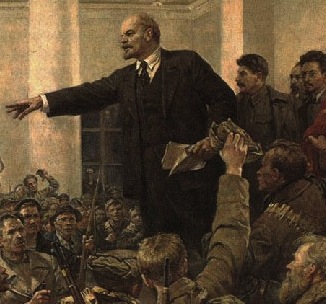
A Soviet Propoganda Poster Communist revolutionary Vladimir Lenin in 1917
Later Life
Amid major political changes in Russia, Stanislavsky mirrored social issues on stage. He survived the violent aftermath of the Communist Revolution of 1917 only due to his close allegiance with Lenin. Shortly afterwards his theater began producing plays containing Soviet propaganda. In 1918, he established the First Studio as a school for training young actors, still trying to gain rightful recognition for acting as a serious profession. In 1938, a month before the open declaration of World War II, Stanislavsky died believing in a peaceful, socially-responsible world. His books have now been translated into over 20 languages and his method has become standard in acting training. Major film actors like Marlin Brando brought it from the stage into the world of motion pictures. Today actors around the world employ Stanislavsky's ideas.


Marlin Brando in "A Streetcar Named Desire" Australian Nicole Kidman, another method actor
Stanislavsky Speaks
A few quotes from Stanislavsky himself about acting and creating a character:
Love the art in yourself, not yourself in the art
Imagination creates things that can be or can happen.
If you know your character's thoughts, the proper vocal and bodily expressions will naturally follow.
When we are on stage, we are in the here and now.
There are no small parts. Only small actors.
Credits
This site was compiled and adapted by Daren Blanck from the following sources:
www.theatrefolk.com/spotlights/the-stanislavsky-system
www.acting-school-stop.com/Stanislavski.html
www.bukisa.com/articles/386857_constantin-sergeyevich-stanislavski
www.articleclick.com/Article/Understanding-Stanislavski-Through-Acting-Exercises/1240068
www.theatrgroup.com/Method/index.html
news.bbc.co.uk/dna/h2g2/A5133151
olga-theatre.blogspot.com/2010/11/stanislavski.html
Stanislavsky Assessment 1
Complete this worksheet in your Google Doc Journal as your assessment:

|
Stanislavsky Worksheet.rtf Size : 3.452 Kb Type : rtf |